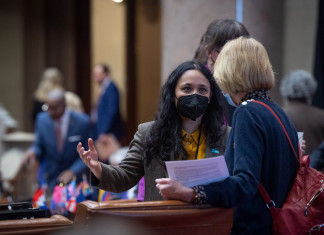Red Hook town budget planners apparently erred last year and have exceeded the state-mandated property tax cap for the 2013 budget, a state audit shows.
Incorrect inclusions in the budget caused the tally to exceed the cap by .33 percent, according to Business Manager Deb Coon, who delivered the bad news at the town board’s Feb. 27 meeting.
Coon said that an auditor from the state comptroller’s office visited the town in February as part of the state’s effort to ensure that towns are correctly calculating the 2 percent cap, which was created in 2011 to curb property tax increases but has proven controversial.
The auditor’s conclusion was that Red Hook had incorrectly calculated the tax cap by $9,857 for its 2013 budget. The town had thought it was not exceeding its tax cap of 2.43 percent at all. [According to the law, there are many factors that affect the tax cap calculation, including inflation and how much the tax base has grown, so a town’s cap would rarely be an even 2 percent. ]
“So, of course, my first question to this gentleman was, why didn’t you come here last year when you started it, or why didn’t you come three months ago?” Coon told the board.
The auditor’s report found that Red Hook Library and Tivoli Free Library’s 414 Proposition Funds, $350,000 in total, were included in the tax cap calculation. But because these budgets are filed separately from the town with the state comptroller, this is not allowed. By law, if the libraries wish to exceed 2 percent of the tax levy, based on the previous year, they must put it before the voters in a referendum. The town acts only as a collection agent for the libraries, Coon explained.
In addition, two amounts that were considered payment in lieu of taxes (PILOT) cannot be considered as such in the future. Hannaford pays the town $2,000 each year to offset the expense of plowing their roadway. And $5,804 is received from tenants of the town’s cell tower and treated “like a pro-rata share of property tax,” according to Coon. This is in addition to their monthly rental fee. Coon said the auditor explained that only tax-exempt groups can be treated as PILOTs, so the funds from Hannaford and the cell tower tenants can’t be part of the tax cap calculation.
In an interview after the meeting, Coon explained that $9,857 is .33 percent of the $2,917,327 in property taxes Red Hook will collect this year. “Although that’s not a significant amount when you compare it to what our total budget is… we said we weren’t going to go over [the cap], and we did,” she said.
Coon brought a resolution before the board that would create a reserve fund for the amount over the levy, as required by the state comptroller’s office. The fund will be taken from the contingency line of the General A fund and applied to next year’s budget to reduce the amount of taxes in 2014. That’s because the excess money was not approved by taxpayers and will be returned to them in the 2014 budget.
The good news, however, is that Red Hook is not alone in making such an error.
The state comptroller’s website reports that 33 percent of New York state towns visited by auditors in 2012 “inaccurately calculated their tax cap.”
In addition, the Gannett News Service’s Albany Bureau reported that 25 percent of the taxing entities in New York overrode the tax cap for their 2013 budgets because of budgetary pressures.
And there was more good news, which Coon delivered at the meeting.
“We wound up [2012] in very good shape; we had no surprises that hurt us financially,” she said. “The big plus…was reestablishing the contingency fund which we had years ago…All the departments worked together to ensure they stayed within their spending limitations.”







Facebook Comments